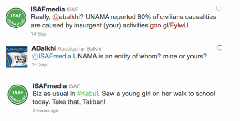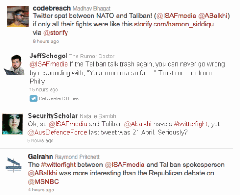Image via Wikipedia
Social media are rapidly becoming a new front line of conflict between NATO forces and the Taliban.
September 15, 2011
The battlefield in the war between NATO's International Security Assistance Force (ISAF) and the Taliban expanded to an unlikely place this week -- Twitter.
I have been closely observing Taliban social media activities for some time now, and have argued that NATO forces should be more open and aggressive in responding to the insurgents’ propaganda.
Finally, ISAF has begun to fight back.
There is an old Pashto proverb that says, “Lies may ruin the village before the truth comes to light."
From a communications standpoint, this has been ISAF's Achilles' heel -- in the past few years, whenever there is a terrorist incident, the media has become aware of it via the Taliban and not through Afghan or NATO officials.
In a sense, this has allowed the Taliban to gain the upper hand in terms of spreading its message.
Up to now, the ISAF Twitter feed has been mostly used to spread news on the training of Afghan police or to issue statements condemning particular events.
The outburst on September 14 seems to have been a departure from this approach and is a welcome counterpoint to the Taliban narrative.
The argument -- or #twitterfight, as it were -- started after a brazen attack on September 13 by Taliban militants on NATO headquarters and the U.S. Embassy in Kabul.
The assault left more than two dozen people dead and over 20 wounded, including children.
Subsequent Twitter hostilities began when @ISAFmedia tweeted: “Re: Taliban spox on #Kabul attack: the outcome is inevitable. Question is how much longer will terrorists put innocent Afghans in harm's way?”
The Taliban’s Twitter response was swift. The @ABalkhi account, which is believed to belong to at least a relatively official Taliban spokesperson, issued the following reply: "@ISAFmedia i dnt knw.u hve bn pttng thm n 'harm's way' fr da pst 10 yrs.Razd whole vllgs n mrkts.n stil hv da nrve to tlk bout 'harm's way'."
It’s worth remembering that the Taliban once banned photography, movies, and the use of the Internet on the grounds that they were all “un-Islamic propaganda.” Now it appears to be using these same tools to “win hearts and minds.”
The exchanged continued like this:
The Taliban have been on Twitter for a while, but this marked the first time they were tested in a direct exchange of heated words.
The highlight came when ISAF taunted another self-proclaimed spokesman’s account by putting a link to a YouTube video of the commander of the NATO-led forces, General John Allen, checking on his soldiers.
@ISAFmedia tweeted: “Hey @alemarahweb, does your boss do this? http://goo.gl/9XpYn #Kabulattacks #ISAF #COMISAF”
Seeing Taliban twitter users on their heels, @ISAFmedia continued to tackle the insurgent group saying: "Biz as usual in #Kabul. Saw a young girl on her walk to school today. Take that, Taliban!”
It seems a lot of people in the international mainstream media had been waiting for ISAF to adopt a more aggressive approach to the Taliban’s social media presence, as most major outlets, from “The Guardian” to “The New York Times”, reported the story.
Regular Twitter users also weighed in. Here’s a sample of the some of the best responses:
-- Bashir Ahmad Gwakh
Read more:
http://www.rferl.org/content/twitterfight_taliban_nato/24329517.html


